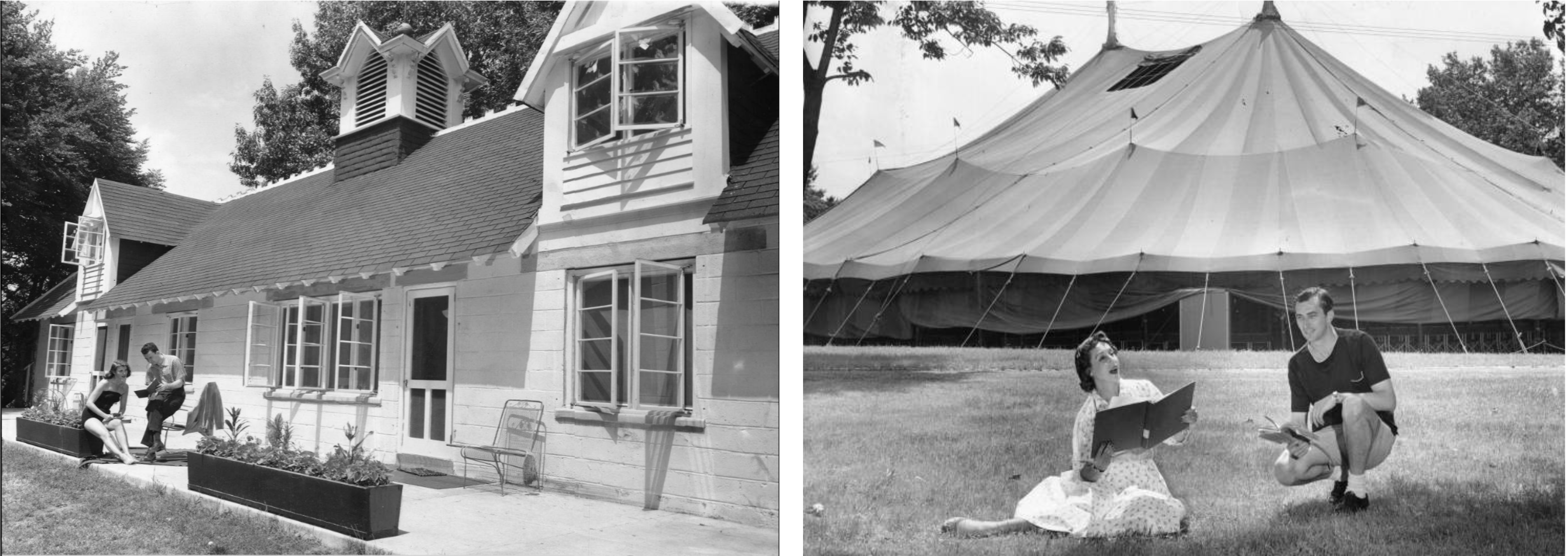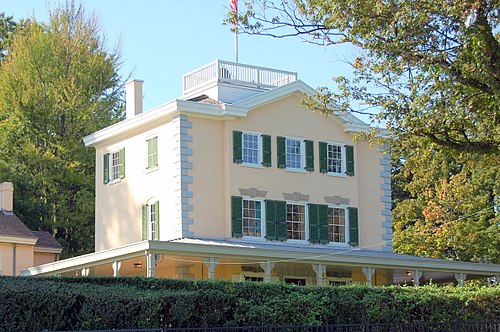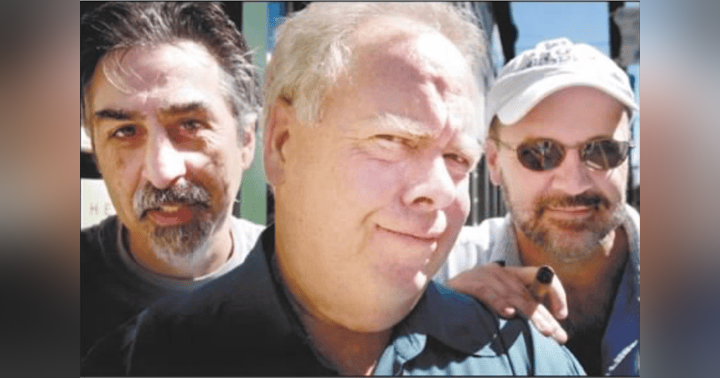
Above, an architect's conception of the new permanent building for the Playhouse in the Park in 1958. The old "sheep barn" - which had acted as a summer "little theater" in the 1920s - is in the foreground. In the upper left corner of the image, one can just spot the historic Belmont Mansion.
Interestingly, when the city of Philadelphia was making a bid to become the home city of the United Nations in 1945, it had proposed erecting the newly-founded international organization's headquarters in this very spot. In Philadelphia's proposal, it had touted the sweeping views of downtown Philadelphia across the Schuylkill River from the Belmont Plateau. Oddly, this proposal did not tempt the assembled world diplomats on the planning committee. Well, their loss. If memory serves, the U.N. ended up somewhere north, up in Manhattan - and nobody ever heard of it again.
Above, a handy diagram and map printed in the Philadelphia Inquirer in June of 1952, showing everyone where the new Playhouse in the Park would be. The first show at the theater was Goodbye, My Fancy, which had been a hit for the actor Conrad Nagle on Broadway three years previously.
Below left, a photo from 1954 of the old tent version of the summer theater in Fairmount Park, as it was in its earliest days. Below right, John B. Kelly - a driving force behind the founding of the Playhouse - and his daughter Grace.
To her doting father's delight, the young actress Grace Kelly appeared at the playhouse in its inaugural 1952 season in the play For Love or Money. Even though her Hollywood career was by then keeping her quite busy, she returned to Philadelphia the following year to join the cast of a comedy called The Moon Is Blue. But that was her last appearance on a Philadelphia stage. Like the United Nations, she ended up going somewhere else.
Above, two examples of typical publicity photos that would be published in the papers during the early years of the Playhouse in the Park - usually featuring the attractive young leading actors of the company. Like many other "straw hat" summer theaters of the 1950s, those first productions scheduled for the theater were rarely artistically ambitious. Light Broadway comedies and musicals were the usual fare. Each show would run a week or so. It's unclear who the lovely couple on the left are, as they pose on the patio of the Sheep Barn in 1955. On the right, actors Arlene Francis and John Baragrey rehearse their roles in the play The Road to Rome in 1953.
(These photos - and many other images in this post - are courtesy of the Special Collection Research Center of the Temple University Library, from the archive of Evening Bulletin.)
Below, another photo from the Evening Bulletin, showing the newly-constructed permanent Playhouse in the Park in 1958. I still find it impressive that it was built, owned and operated by the City of Philadelphia - similar to the Robin Hood Dell open air concert space on the east side of the park. It was the only theater in Philadelphia ever to have local government funding. (Of course, as we learn in the podcast episode, that inevitably led to political complications, petty disputes and budget constraints. This is why we can't have nice things.)
As the architects designed it, the playhouse mimicked the shape of the tent it had replaced, and had over 1400 seats in a 'theater-in-the-round' arrangement. When first built, however, it did not have air conditioning. Ethelyn Thrasher, who assumed leadership of the theater, managed to get a cooling system installed by 1963, much to the relief of audiences and actors.
Below left, in a newspaper photo from May of 1962 - just before the season that was to cause her so much grief - Ethelyn Thrasher was given an award for leadership of the Playhouse in a ceremony at the Bellevue-Stratford Hotel. Next to her is the star Walter Slezak (son of the opera singer Leo Slezak, who had often sung at the Academy of Music in his day.)
That year Walter Slezak had a big success playing Berenger in a production of Ionesco's absurdist drama Rhinoceros at the Playhouse - one of the more ambitious shows that Thrasher had produced. But later, of course, his allegation that Thrasher asked him to kick back some of his salary to her would result in one of the legal charges brought against her the following year. (Slezak never showed up in court to testify under oath, and the charges were dismissed.)
Below right, a photo of a smiling and confident Ethelyn Thrasher published in the Philadelphia Inquirer in 1963, accompanying a news story about the supposed "Scandal in the Park."
After the story broke that Mayor Tate had somehow "banned" a production of the Brecht/Weill musical The Threepenny Opera at the Playhouse, other local theaters and producers had a field day. Both the Society HIll Playhouse (in Philadelphia) and the Lambertville Music Circus (in New Jersey) touted that their version of the famous underworld drama could be seen in full, despite the "ban."
Above, in a photo from the Philadelphia Evening Bulletin, Mayor James H. Tate enters the voting booth to cast his ballot for himself in the November 1963 election for Mayor. Below, Tate's political rival, Comptroller Alexander Hemphill, and two aides, in a photo from the Philadelphia Daily News. Hemphill was in the middle of investigating a fraud scheme he claimed to have uncovered involving city parking meters. When that did not seem to gain him much political traction, Hemphill's office turned to investigating alleged corruption in the city-run Playhouse in the Park.
Below, another headline and photo from the Daily News, this time from early January 1964. By this time Thrasher had been arrested and arraigned, and was appearing in court with her attorney Walter Stein. By coincidence one of Hemphill's aides was also named Stein (see above), but the two men were not related. In the end, the charges against Thrasher were dismissed, but by then she had left her leadership of the Playhouse. There would not be another female leader of a major Philadelphia theater organization for another two decades.
We will perhaps tell the full story of the Playhouse in the Park at a later date. But in brief, attendance at the city-owned summer theater sputtered in the 1970s, as it tried to present more 'relevant' plays. But it could never hope to compete with privately owned and operated big summer theaters in the area. These could afford to pay the large guaranteed "appearance fees" to big stars that would attract audiences. The Valley Forge Music Fair in Devon, for example, could get Angela Lansbury to reprise her work on Broadway in the musical Gypsy. And the Valley Forge Music Fair theater, built in 1973, held twice as many people as the Playhouse in the Park.
The City of Philadelphia, in fact, was having huge financial issues by that point in time, and its parks and recreation budget was slashed - along with many other things. After the summer of 1979, no shows were staged at the Playhouse again, and it sat vacant for almost two decades. Many attempts were made to rent the venue, but there were few takers.
In 1997 the decision was finally made to demolish the theater. The site is now open parkland. Fortunately, the historic old Belmont Mansion nearby remains. Since 2007 it has hosted The Underground Railroad Museum, and its dining terrace is a popular rental site for wedding receptions during the spring and summer months.
Selected Bibliography:
Books
Clark, Joseph S. Jr., and Dennis J. Clark, "Rally and Relapse: 1946-1968" in Philadelphia: A 300-Year History, Russel F. Weigley, ed., W.W. Norton & Company, 1982, pp. 649-703.
Davis, Andrew, America's Longest Run: A History of the Walnut Street Theatre, Chapter 10: “The Syndicate Years,” The Pennsylvania State University Press, 2010, p. 268.
Newspaper articles (in chronological order):
"Walk Out On Spicy Show: Sayreville Principal Leads the Exodus," The Central New Jersey Home News, November 7, 1961. p. 1.
"Spicy Playwright Chides Walkout," Philadelphia Inquirer, November 8, 1961, p. 39.
"Comedy by Krasna," by Barbara Wilson, Philadelphia Inquirer, November 19, 1961. p. 93.
"Sunday in New York Provokes Laughs," by Ernest Scheier, Philadelphia Evening Bulletin, November 21, 1961.
"Krasna Extracts Fizz From Sturdy Farce," by Henry Murdoch, Philadelphia Inquirer, November 21, 1961, p. 20.
"Mayor Hit as Play Censor," by Donald A. McDonough, Philadelphia Inquirer, July 16, 1962, p. 1.
"Tate Batted, Patted," by Donald A. McDonough, Philadelphia Inquirer, July 17, 1962, p. 21.
"Who Knifed Mack the Knife?", by Donald A. McDonough, Philadelphia Inquirer, July 18, 1962, p. 1.
"Threepenny Opera Dangerous Fare," by Samuel Singer, Philadelphia Inquirer, July 19, 1962, p. 24.
"Mack is Back: Tate Ribbed as Censor," Philadelphia Inquirer, July 26, 1962. p. 32.
"Playhouse Overspending is Charged, Philadelphia Inquirer, August 8, 1962, p. 19.
"Dilworth Calls Hemphill 'Judas and Bum'," Philadelphia Evening Bulletin, August 22, 1962. p. 1.
"2-Week Runs Blamed for Playhouse Penury," Philadelphia Inquirer, August 23, 1962, p. 24.
"Latest Thrasher Drama Begins Act 2 in Court," Philadelphia Daily News, January 3, 1964, p. 4.
"Court Cancels Trial of Mrs. Thrasher for Lack of 'Second Act'," Philadelphia Inquirer, November 16, 1965, p. 39.


















